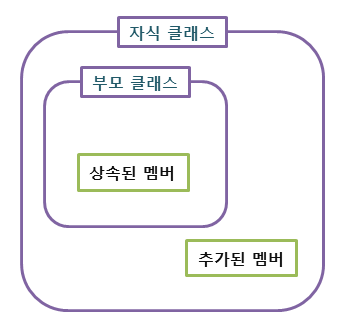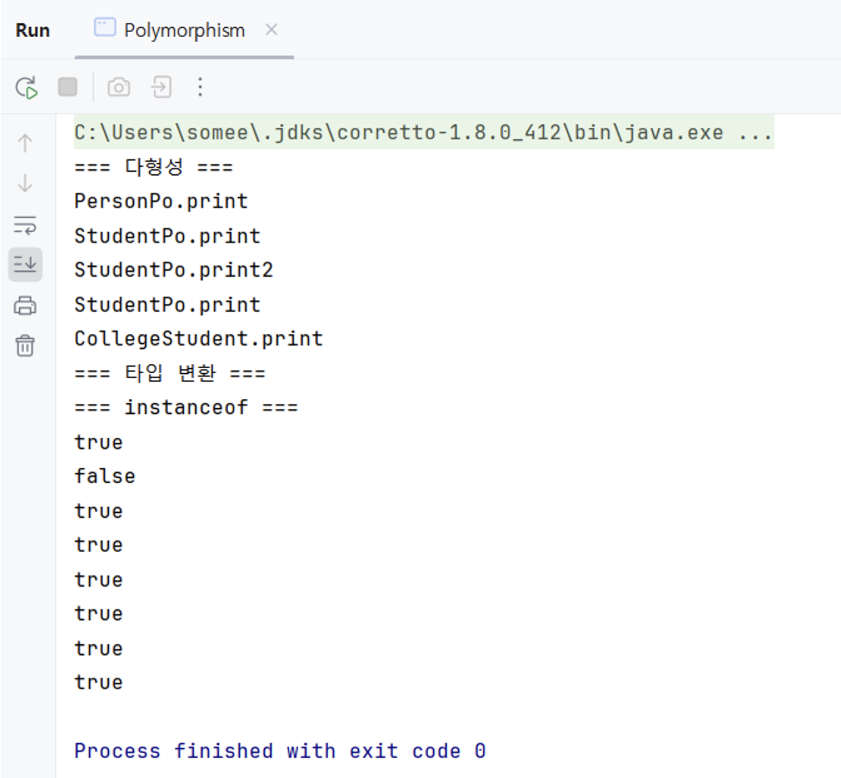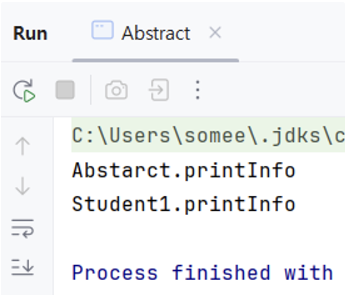반응형
1. 클래스와 객체
1) 클래스
- 객체를 정의하는 설계도
- 객체 변수(멤버 변수)와 메서드로 이루어짐
public class 클래스명 {
// 객체 변수
// 메서드
// +접근제어자
// +static
}
클래스명 객체명 = new 클래스명();
2) 객체/인스턴스
(1) 객체(Object)
- 실체
(2) 인스턴스(Instance)
- 클래스와 객체의 관계
- 인스턴스화: 클래스로부터 객체 선언
- 어떤 객체는 어떤 클래스의 인스턴스일 수 있음
3) 생성자(Constructor)
- 객체가 생성될 때 자동으로 호출
- 생성자 규칙
- 클래스명과 이름 맞추기
- 리턴 타입 없음
public class 클래스명 {
클래스명(){}
}
4) this, this()
(1) this
- 객체 자신을 의미
(2) this()
- 생성자
5) 오버로딩(Overloading)
- 한 클래스 내에서 같은 이름의 메서드를 여러개 정의 가능
- 조건: 메서드의 이름이 같으면서, 매개변수의 개수 또는 타입이 달라야 함(리턴타입과는 관련 없음)
6) 접근제어자
- 클래스의 변수나 메서드의 접근에 제한을 두는 키워드
- 종류
| private | 해당 클래스에서만 접근 |
| public | 어디서나 접근 |
| default | 해당 패키지 내에서만 접근 |
| protected | 해당 패키지 및 상속받은 클래스에서 접근 |

7) Static
- 변수나 메서드의 특성을 바꿈
→ 메모리에 한 번만 할당되며, Static 변수와 메서드는 공유됨 - Static 클래스 변수: 해당 클래스의 각 객체들이 값을 공유
- Static 클래스 메서드: 객체를 생성하지 않아도 호출 가능
* 예제 실습
// Java 프로그래밍 - 클래스와 객체
// Car 클래스 - 객체변수, 메서드
class Car {
String name;
String type;
// 기본생성자(생략가능)
// Car(){}
public void printCarInfo() {
System.out.println("== Car Info ==");
System.out.println("name = " + name);
System.out.println("type = " + type);
}
public void move() {
System.out.println("이동!");
}
public void brake() {
System.out.println("정지!");
}
}
// Car2 클래스 - 생성자, this
class Car2 {
String name;
String type;
// 기본생성자(생략가능)
// Car2(){}
// 생성자
Car2(String name, String type) {
this.name = name;
this.type = type;
System.out.println("생성자 출력!");
}
public void printCarInfo() {
System.out.println("== Car2 Info ==");
System.out.println("name = " + name);
System.out.println("type = " + type);
}
public void load() {
System.out.println("짐을 주세요!");
}
public void horn() {
System.out.println("빵빵!");
}
}
public class ClassAndObject {
public static void main(String[] args) {
// Car 클래스 사용
Car car1 = new Car();
car1.name = "a";
car1.type = "suv";
car1.printCarInfo();
car1.move();
car1.brake();
// Car2 클래스 사용
Car2 car2 = new Car2("b", "sedan");
car2.printCarInfo();
car2.load();
car2.horn();
}
}
** ClassAndObject.java 수정, Car2.java 생성
// Java 프로그래밍 - 클래스와 객체
import car.Car2;
// Car 클래스 - 객체변수, 메서드
class Car {
String name;
String type;
// 기본생성자(생략가능)
// Car(){}
Car(String name, String type) {
this.name = name;
this.type = type;
}
public void printCarInfo() {
System.out.println("== Car Info ==");
System.out.println("name = " + name);
System.out.println("type = " + type);
}
// 오버로딩 구현
public void printCarInfo(String date) {
this.printCarInfo();
System.out.println("date: " + date);
}
public void printCarInfo(int number) {
this.printCarInfo();
System.out.println("number: " + number);
}
public void printCarInfo(String date, int number) {
this.printCarInfo();
System.out.println("date: " + date + "," + "number: " + number);
}
}
// Car2 클래스 - 생성자, this
class Car3 {
// 스태틱 변수
static String name = "None";
String type;
// 기본생성자(생략가능)
// Car2(){}
// 생성자
Car3(String name, String type) {
this.name = name;
this.type = type;
}
public void printCarInfo() {
System.out.println("== Car2 Info ==");
System.out.println("name = " + name);
System.out.println("type = " + type);
}
// 스태틱 메서드
public static void getName() {
System.out.println("Car name: " + name);
}
}
public class ClassAndObject {
public static void main(String[] args) {
Car car1 = new Car("a", "sedan");
car1.printCarInfo();
// 1. 오버로딩 사용
System.out.println(("=== 오버로딩 사용 ==="));
car1.printCarInfo("2022");
car1.printCarInfo(1234);
car1.printCarInfo("2022", 1234);
// 2. 접근 제어자
System.out.println("\\n=== 접근 제어자 ===");
Car2 car2 = new Car2("a", "b", "c", "d");
System.out.println(car2.name1);
// System.out.println(car2.name2);
// System.out.println(car2.name3);
// System.out.println(car2.name4);
// 3. static;
System.out.println("\\n=== static ===");
Car3.getName();
Car3 car3_1 = new Car3("a", "sedan");
Car3 car3_2 = new Car3("b", "suv");
Car3 car3_3 = new Car3("c", "rv");
car3_1.printCarInfo();
car3_2.printCarInfo();
car3_3.printCarInfo();
}
}
// Car2.java
package car;
public class Car2 {
public String name1;
private String name2; // private: getter, setter가 없으면 다른 클래스에서 접근 불가능
protected String name3; // protected: 해당 패키지를 상속받지 않아 접근 불가능
String name4; // default: 해당 패키지 내에서만 접근 가능
public Car2(String name1, String name2, String name3, String name4) {
this.name1 = name1;
this.name2 = name2;
this.name3 = name3;
this.name4 = name4;
}
}*** 출력 결과

2. 상속
- 기존 클래스에 기능 추가 및 재정의하여 새로운 클래스 정의
- 부모 클래스: 상속 대상이 되는 기존 클래스 (=상위 클래스, 기초클래스)
- 자식 클래스: 기존 클래스를 상속하는 클래스 (=하위 클래스, 파생 클래스)
- 부모 클래스의 필드와 메소드가 상속됨 (생성자/초기화 블록은 상속 x)
- 다중 상속은 불가능
- private는 자식 클래스에서 접근 불가, default는 내부 패키지의 자식 클래스에서는 접근 가능

1) super, super()
(1) super
- 부모 클래스와 자식 클래스의 멤버 이름이 같을 때 구분하는 키워드
(2) super()
- 부모 클래스의 생성자 호출
2) 오버라이딩(Overriding)
- 부모 클래스의 메서드를 자식 클래스에서 재정의
- 조건
- 메서드의 선언부가 부모 클래스의 메서드와 동일해야 함
- 반환 타입에 한해, 부모 클래스의 반환 타입으로 형변환할 수 있는 타입으로 변경 가능
- 부모 클래스의 메서드보다 접근제어자를 더 좁은 범위로 변경 불가
- 부모 클래스의 메서드보다 더 큰 범위의 예외 선언 불가
3) 예제 실습
// Java 기초 - 상속
// Person 클래스 - Student 클래스의 부모
class Person {
String name;
int age;
public int a1;
private int a2;
// 기본 생성자(생략가능)
Person() {}
// 생성자
Person(String name, int age) {
this.name = name;
this.age = age;
}
public void printInfo() {
System.out.println("=== Person.printInfo ===");
System.out.println("name: " + name);
System.out.println("age: " + age);
}
}
// Student 클래스 - Person 클래스 상속, 접근제어자 확인
class Student extends Person {
Student() {
a1 = 1;
//a2 = 1; //오류
}
}
// Student2 클래스 - Person 클래스 상속, super 사용, 오버라이딩
class Student2 extends Person {
String name;
int stdId;
Student2(String name, int age, int stdId) {
//this.name = name;
//super.name = name;
//super(name, age);
this.age = age;
this.stdId = stdId;
}
public void printInfo() {
System.out.println("=== Student2.printInfo ===");
System.out.println("name: " + name);
System.out.println("age: " + age);
System.out.println("stdId: " + stdId);
}
}
public class Inheritance {
public static void main(String args[]) {
// 1. 상속
System.out.println("=== 상속 ===");
Student s1 = new Student();
s1.name = "a";
s1.age = 25;
s1.printInfo();
// 2. super, super(), 오버라이딩
System.out.println("=== super, super(), 오버라이딩 ===");
Student2 s2 = new Student2("b", 32, 1);
s2.printInfo();
}
}

3. 다형성(Polymorphism)
- 한 객체가 여러 가지 타입을 가질 수 있는 것
- 부모클래스 타입의 참조 변수로 자식클래스 인스턴스 참조
class Person {} class Student extends Person {} Person p1 = new Student(); // Student s1 = new Person(); // 오류
1) instanceof
- 실제 참조하고 있는 인스턴스의 타입 확인
class Person {}
class Student extends Person {}
Person p1 = new Student();
// Student s1 = new Person(); // 오류
System.out.println(p1 instanceof Person);
2) 예제 실습
// Java 프로그래밍 - 다형성
class PersonPo {
public void print() {
System.out.println("PersonPo.print");
}
}
class StudentPo extends PersonPo {
public void print() {
System.out.println("StudentPo.print");
}
public void print2() {
System.out.println("StudentPo.print2");
}
}
class CollegeStudent extends PersonPo {
public void print() {
System.out.println("CollegeStudent.print");
}
}
public class Polymorphism {
public static void main(String[] args) {
// 1. 다형성
System.out.println("=== 다형성 ===");
PersonPo p1 = new PersonPo();
StudentPo s1 = new StudentPo();
PersonPo p2 = new StudentPo();
// StudentPo sp2 = new PersonPo();
p1.print();
s1.print();
s1.print2();
p2.print();
// p2.print2();
PersonPo p3 = new CollegeStudent();
// CollegeStudent c1 = new StudentPo();
p3.print();
// 2. 타입 변환
System.out.println("=== 타입 변환 ===");
PersonPo pp1 = null;
StudentPo ss1 = null;
PersonPo pp2 = new PersonPo();
StudentPo ss2 = new StudentPo();
PersonPo pp3 = new StudentPo(); // 업캐스팅
pp1 = pp2;
pp1 = ss2;
ss1 = ss2;
// ss1 = pp2;
ss1 = (StudentPo)pp3; // 다운캐스팅
// 3. instanceof
System.out.println("=== instanceof ===");
PersonPo pe1 = new PersonPo();
StudentPo st1 = new StudentPo();
PersonPo pe2 = new StudentPo();
PersonPo pe3 = new CollegeStudent();
System.out.println(pe1 instanceof PersonPo);
System.out.println(pe1 instanceof StudentPo);
System.out.println(st1 instanceof StudentPo);
System.out.println(st1 instanceof PersonPo);
System.out.println(pe2 instanceof PersonPo);
System.out.println(pe2 instanceof StudentPo);
System.out.println(pe3 instanceof PersonPo);
System.out.println(pe3 instanceof CollegeStudent);
if (pe1 instanceof StudentPo) {
StudentPo stu1 = (StudentPo) pe1;
}
if (st1 instanceof PersonPo) {
PersonPo per1 = (PersonPo) st1;
}
}
}

4. 추상 클래스
1) 추상 메서드 (Abstract Method)
- 자식클래스에서 반드시 오버라이딩 해야 하는 메서드
- 선언만 하고 구현 내용은 없음
abstract void print();
2) 추상 클래스 (Abstract Class)
- 하나 이상의 추상 메서드를 포함하는 클래스
- 반드시 구현해야 하는 부분에 대해 명시적으로 표현
- 추상 클래스 자체는 객체 생성 불가
abstract class 클래스명 {
...
abstract void print();
}
3) 예제 실습
// Java 기초 - 추상 클래스
// 추상 클래스 Person1
abstract class Person1 {
abstract void printInfo();
}
// 추상 클래스 상속
class Student1 extends Person1 {
public void printInfo(){
System.out.println("Student1.printInfo");
};
}
public class Abstract {
public static void main(String[] args) {
// 추상 클래스의 사용
// Person1 p1 = new Person1();
Person1 p1 = new Person1() {
@Override
void printInfo() {
System.out.println("Abstarct.printInfo");
}
};
p1.printInfo();
Student1 s1 = new Student1();
s1.printInfo();
}
}

반응형
'자바(JAVA) > 미니 프로젝트 & 기초 공부' 카테고리의 다른 글
| Java 기초 다시 공부하기 8주차 - 람다식, 스트림 (0) | 2024.08.27 |
|---|---|
| Java 기초 다시 공부하기 7주차 - 인터페이스, 내부클래스/익명클래스, 입출력, 예외 처리, 컬렉션 프레임워크 (0) | 2024.08.22 |
| Java 기초 다시 공부하기 5주차 - Java, 변수와 자료형, 연산자, 조건문, 반복문, 다차원 배열 (0) | 2024.08.09 |
| Java 기초 다시 공부하기 4주차 - 달력 출력 프로그램, 가상 대선 당선 시뮬레이션 프로그램 (0) | 2024.06.30 |
| Java 기초 다시 공부하기 3주차-놀이동산 입장권 계산 프로그램 구현, 주민등록번호 생성 프로그램 구현 (1) | 2024.06.22 |